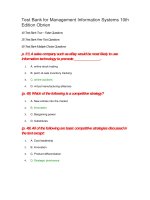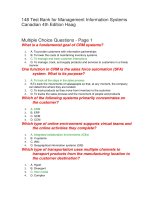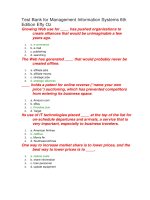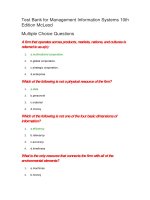Test bank principles of information systems 12e ch1
Bạn đang xem bản rút gọn của tài liệu. Xem và tải ngay bản đầy đủ của tài liệu tại đây (100.24 KB, 21 trang )
Chapter 01: An Introduction to Information Systems
1. Data represents real-world things.
a. True
b. Fals
e
ANSWER:
True
POINTS:
1
DIFFICULTY:
Easy
LEARNING OBJECTIVES: 01.02
NATIONAL STANDARDS: United States - BUSPROG - Technology
KEYWORDS:
Bloom's: Knowledge
2. Information is simply a collection of raw facts such as an employee number or the total hours worked in a week.
a. True
b. Fals
e
ANSWER:
False
POINTS:
1
DIFFICULTY:
Easy
LEARNING OBJECTIVES: 01.02
NATIONAL STANDARDS: United States - BUSPROG - Technology
KEYWORDS:
Bloom's: Knowledge
3. Information and data are essentially the same thing.
a. True
b. Fals
e
ANSWER:
False
POINTS:
1
DIFFICULTY:
Easy
LEARNING OBJECTIVES: 01.02
NATIONAL STANDARDS: United States - BUSPROG - Technology
KEYWORDS:
Bloom's: Knowledge
4. A set of logically related tasks performed to achieve a definite outcome is called a process.
a. True
b. Fals
e
ANSWER:
True
POINTS:
1
DIFFICULTY:
Easy
LEARNING OBJECTIVES: 01.02
NATIONAL STANDARDS: United States - BUSPROG - Technology
KEYWORDS:
Bloom's: Knowledge
5. Using a computer to forecast future sales and order more inventory before a shortage can occur is an example of
Cengage Learning Testing, Powered by Cognero
Page 1
Chapter 01: An Introduction to Information Systems
information system feedback.
a. True
b. Fals
e
ANSWER:
False
POINTS:
1
DIFFICULTY:
Easy
LEARNING OBJECTIVES: 01.03
NATIONAL STANDARDS: United States - BUSPROG - Technology
KEYWORDS:
Bloom's: Knowledge
6. A computer-based information system (CBIS) is a single set of hardware, software, databases, telecommunications,
people, and procedures configured to collect, manipulate, store, and process data into information.
a. True
b. Fals
e
ANSWER:
True
POINTS:
1
DIFFICULTY:
Easy
LEARNING OBJECTIVES: 01.04
NATIONAL STANDARDS: United States - BUSPROG - Technology
KEYWORDS:
Bloom's: Knowledge
7. The technology infrastructure is a set of shared IS resources that form the foundation of each computer-based
information system.
a. True
b. Fals
e
ANSWER:
True
POINTS:
1
DIFFICULTY:
Easy
LEARNING OBJECTIVES: 01.04
NATIONAL STANDARDS: United States - BUSPROG - Technology
KEYWORDS:
Bloom's: Knowledge
8. Increasingly, companies are incorporating computer-based information systems into their products and services.
a. True
b. Fals
e
ANSWER:
True
POINTS:
1
DIFFICULTY:
Easy
LEARNING OBJECTIVES: 01.04
NATIONAL STANDARDS: United States - BUSPROG - Technology
KEYWORDS:
Bloom's: Knowledge
Cengage Learning Testing, Powered by Cognero
Page 2
Chapter 01: An Introduction to Information Systems
9. A drawback of an information system (IS) is that it lacks a feedback mechanism.
a. True
b. Fals
e
ANSWER:
True
POINTS:
1
DIFFICULTY:
Easy
LEARNING OBJECTIVES: 01.01
NATIONAL STANDARDS: United States - BUSPROG - Technology
KEYWORDS:
Bloom's: Knowledge
10. Both system software and application software are needed for all types of computers, from small handheld computers
to large supercomputers.
a. True
b. Fals
e
ANSWER:
True
POINTS:
1
DIFFICULTY:
Easy
LEARNING OBJECTIVES: 01.04
NATIONAL STANDARDS: United States - BUSPROG - Technology
KEYWORDS:
Bloom's: Knowledge
11. Application software, such as Microsoft Windows, manages basic computer operations such as start-up.
a. True
b. Fals
e
ANSWER:
False
POINTS:
1
DIFFICULTY:
Easy
LEARNING OBJECTIVES: 01.04
NATIONAL STANDARDS: United States - BUSPROG - Technology
KEYWORDS:
Bloom's: Knowledge
12. A user can install a firewall to avoid viruses and prevent unauthorized people from gaining access to his or her
computer system.
a. True
b. Fals
e
ANSWER:
True
POINTS:
1
DIFFICULTY:
Easy
LEARNING OBJECTIVES: 01.07
NATIONAL STANDARDS: United States - BUSPROG - Technology
KEYWORDS:
Bloom's: Knowledge
Cengage Learning Testing, Powered by Cognero
Page 3
Chapter 01: An Introduction to Information Systems
13. Organizations invest heavily in information systems to improve customer service.
a. True
b. Fals
e
ANSWER:
True
POINTS:
1
DIFFICULTY:
Easy
LEARNING OBJECTIVES: 01.08
NATIONAL STANDARDS: United States - BUSPROG - Technology
KEYWORDS:
Bloom's; Knowledge
14. The World Wide Web (WWW) is a network of links on the Internet to documents containing text, graphics, video, and
sound.
a. True
b. Fals
e
ANSWER:
True
POINTS:
1
DIFFICULTY:
Easy
LEARNING OBJECTIVES: 01.04
NATIONAL STANDARDS: United States - BUSPROG - Technology
KEYWORDS:
Bloom's: Knowledge
15. An intranet is a network based on Web technologies that allows selected outsiders, such as business partners and
customers, to access authorized resources of a company’s extranet.
a. True
b. Fals
e
ANSWER:
False
POINTS:
1
DIFFICULTY:
Easy
LEARNING OBJECTIVES: 01.04
NATIONAL STANDARDS: United States - BUSPROG - Technology
KEYWORDS:
Bloom's: Knowledge
16. C2C stands for computer-to-computer e-commerce.
a. True
b. Fals
e
ANSWER:
False
POINTS:
1
DIFFICULTY:
Easy
LEARNING OBJECTIVES: 01.05
NATIONAL STANDARDS: United States - BUSPROG - Technology
KEYWORDS:
Bloom's: Knowledge
Cengage Learning Testing, Powered by Cognero
Page 4
Chapter 01: An Introduction to Information Systems
17. Mobile commerce (m-commerce) is the use of mobile, wireless devices to place orders and conduct business.
a. True
b. Fals
e
ANSWER:
True
POINTS:
1
DIFFICULTY:
Easy
LEARNING OBJECTIVES: 01.05
NATIONAL STANDARDS: United States - BUSPROG - Technology
KEYWORDS:
Bloom's: Knowledge
18. While technologically advanced, unfortunately, e-commerce offers few advantages for streamlining work activities.
a. True
b. Fals
e
ANSWER:
False
POINTS:
1
DIFFICULTY:
Easy
LEARNING OBJECTIVES: 01.05
NATIONAL STANDARDS: United States - BUSPROG - Technology
KEYWORDS:
Bloom's: Knowledge
19. Electronic business (e-business) goes beyond e-commerce and e-procurement by using information systems and the
Internet to perform all business-related tasks and functions.
a. True
b. Fals
e
ANSWER:
True
POINTS:
1
DIFFICULTY:
Easy
LEARNING OBJECTIVES: 01.05
NATIONAL STANDARDS: United States - BUSPROG - Technology
KEYWORDS:
Bloom's: Knowledge
20. Since the 1950s, computers have been used to perform common business applications.
a. True
b. Fals
e
ANSWER:
True
POINTS:
1
DIFFICULTY:
Easy
LEARNING OBJECTIVES: 01.05
NATIONAL STANDARDS: United States - BUSPROG - Technology
KEYWORDS:
Bloom's: Knowledge
Cengage Learning Testing, Powered by Cognero
Page 5
Chapter 01: An Introduction to Information Systems
21. A decision support system (DSS) can include a collection of models used to support a decision maker or user, a
collection of facts and information to assist in decision making, and systems and procedures that help decision makers and
other users interact with the DSS.
a. True
b. Fals
e
ANSWER:
True
POINTS:
1
DIFFICULTY:
Easy
LEARNING OBJECTIVES: 01.05
NATIONAL STANDARDS: United States - BUSPROG - Technology
KEYWORDS:
Bloom's: Knowledge
22. A management information system (MIS) typically provides standard reports generated with data and information
from a transaction processing system (TPS) or enterprise resource planning (ERP) system.
a. True
b. Fals
e
ANSWER:
True
POINTS:
1
DIFFICULTY:
Easy
LEARNING OBJECTIVES: 01.05
NATIONAL STANDARDS: United States - BUSPROG - Technology
KEYWORDS:
Bloom's: Knowledge
23. A management information system (MIS) goes beyond a traditional decision support system (DSS) by providing
immediate assistance in solving problems.
a. True
b. Fals
e
ANSWER:
False
POINTS:
1
DIFFICULTY:
Easy
LEARNING OBJECTIVES: 01.05
NATIONAL STANDARDS: United States - BUSPROG - Technology
KEYWORDS:
Bloom's: Knowledge
24. Neural networks give the computer the ability to make suggestions and function like an expert in a particular field,
helping enhance the performance of novice users.
a. True
b. Fals
e
ANSWER:
False
POINTS:
1
DIFFICULTY:
Easy
LEARNING OBJECTIVES: 01.05
Cengage Learning Testing, Powered by Cognero
Page 6
Chapter 01: An Introduction to Information Systems
NATIONAL STANDARDS: United States - BUSPROG - Technology
KEYWORDS:
Bloom's: Knowledge
25. Some successful stock, options, and futures traders use expert systems to spot trends and improve the profitability of
their investments.
a. True
b. Fals
e
ANSWER:
False
POINTS:
1
DIFFICULTY:
Easy
LEARNING OBJECTIVES: 01.05
NATIONAL STANDARDS: United States - BUSPROG - Technology
KEYWORDS:
Bloom's: Knowledge
26. The unique value of learning systems is that they allow organizations to capture and use the wisdom of experts and
specialists.
a. True
b. Fals
e
ANSWER:
False
POINTS:
1
DIFFICULTY:
Easy
LEARNING OBJECTIVES: 01.05
NATIONAL STANDARDS: United States - BUSPROG - Technology
KEYWORDS:
Bloom's: Knowledge
27. Augmented reality is a new form of virtual reality that enables a user to become fully immersed in an artificial,
computer-generated 3D world.
a. True
b. Fals
e
ANSWER:
False
POINTS:
1
DIFFICULTY:
Easy
LEARNING OBJECTIVES: 01.05
NATIONAL STANDARDS: United States - BUSPROG - Technology
KEYWORDS:
Bloom's: Knowledge
28. Systems development increases the cost and effort associated with operating an existing system.
a. True
b. Fals
e
ANSWER:
False
POINTS:
1
DIFFICULTY:
Easy
Cengage Learning Testing, Powered by Cognero
Page 7
Chapter 01: An Introduction to Information Systems
LEARNING OBJECTIVES: 01.06
NATIONAL STANDARDS: United States - BUSPROG - Technology
KEYWORDS:
Bloom's: Knowledge
29. Systems analysis involves studying the existing system to uncover its strengths and weaknesses.
a. True
b. Fals
e
ANSWER:
True
POINTS:
1
DIFFICULTY:
Easy
LEARNING OBJECTIVES: 01.06
NATIONAL STANDARDS: United States - BUSPROG - Technology
KEYWORDS:
Bloom's: Knowledge
30. Integration and testing involves converting the system design into an operational information system.
a. True
b. Fals
e
ANSWER:
False
POINTS:
1
DIFFICULTY:
Easy
LEARNING OBJECTIVES: 01.06
NATIONAL STANDARDS: United States - BUSPROG - Technology
KEYWORDS:
Bloom's: Knowledge
31. In the context of an information system, _____ involves keeping data and information available for future use.
a. input
b. storage
c. feedback
d. retrieval
ANSWER:
b
POINTS:
1
DIFFICULTY:
Easy
LEARNING OBJECTIVES: 01.03
NATIONAL STANDARDS: United States - BUSPROG - Technology
KEYWORDS:
Bloom's: Knowledge
32. The process of defining relationships among data to create useful information requires ______.
a. an information
b. intelligence
system
c. knowledge
d. intuition
ANSWER:
c
POINTS:
1
DIFFICULTY:
Easy
LEARNING OBJECTIVES: 01.02
NATIONAL STANDARDS: United States - BUSPROG - Technology
Cengage Learning Testing, Powered by Cognero
Page 8
Chapter 01: An Introduction to Information Systems
KEYWORDS:
Bloom's: Knowledge
33. ______ are people who create, use, and disseminate knowledge and are usually professionals in science, engineering,
business, and other areas.
a. Systems analysts
b. Knowledge workers
c. Knowledge database
d. End users
administrators
ANSWER:
b
POINTS:
1
DIFFICULTY:
Easy
LEARNING OBJECTIVES: 01.02
NATIONAL STANDARDS: United States - BUSPROG - Technology
KEYWORDS:
Bloom's: Knowledge
34. Quality information that can be used for a variety of purposes is said to be ______.
a. flexible
b. economical
c. relevan
d. verifiable
t
ANSWER:
a
POINTS:
1
DIFFICULTY:
Easy
LEARNING OBJECTIVES: 01.02
NATIONAL STANDARDS: United States - BUSPROG - Technology
KEYWORDS:
Bloom's: Knowledge
35. The value of information is directly linked to how it helps decision makers achieve their organization’s _____.
a. culture
b. goals
c. cost reduction initiatives
d. quality improvement measures
ANSWER:
b
POINTS:
1
DIFFICULTY:
Moderate
LEARNING OBJECTIVES: 01.02
NATIONAL STANDARDS: United States - BUSPROG - Technology
KEYWORDS:
Bloom's: Knowledge
36. A _____ is a set of elements or components that interact to accomplish goals.
a. process
b. databas
e
c. network
d. system
ANSWER:
d
POINTS:
1
DIFFICULTY:
Easy
LEARNING OBJECTIVES: 01.03
NATIONAL STANDARDS: United States - BUSPROG - Technology
KEYWORDS:
Bloom's: Knowledge
Cengage Learning Testing, Powered by Cognero
Page 9
Chapter 01: An Introduction to Information Systems
37. In information systems, _____ is information from a system that is used to make changes to input or processing
activities.
a. a program
b. feedback
c. an output
d. software
ANSWER:
b
POINTS:
1
DIFFICULTY:
Easy
LEARNING OBJECTIVES: 01.03
NATIONAL STANDARDS: United States - BUSPROG - Technology
KEYWORDS:
Bloom's: Knowledge
38. _____ consists of computer equipment used to perform input, processing, and output activities.
a. The motherboard
b. A register
c. Software
d. Hardware
ANSWER:
d
POINTS:
1
DIFFICULTY:
Easy
LEARNING OBJECTIVES: 01.04
NATIONAL STANDARDS: United States - BUSPROG - Technology
KEYWORDS:
Bloom's: Knowledge
39. A _____ is an example of a hardware processing device.
a. keyboard
b. printe
r
c. scanner
d. chip
ANSWER:
d
POINTS:
1
DIFFICULTY:
Easy
LEARNING OBJECTIVES: 01.04
NATIONAL STANDARDS: United States - BUSPROG - Technology
KEYWORDS:
Bloom's: Knowledge
40. _____ consists of computer programs that govern the operation of a computer.
a. Hardware
b. Software
c. A server
d. The Internet
ANSWER:
b
POINTS:
1
DIFFICULTY:
Easy
LEARNING OBJECTIVES: 01.04
NATIONAL STANDARDS: United States - BUSPROG - Technology
KEYWORDS:
Bloom's: Knowledge
41. _____ connect computers and equipment in a building, around the country, or around the world to enable electronic
communications.
Cengage Learning Testing, Powered by Cognero
Page 10
Chapter 01: An Introduction to Information Systems
a. Programs
b. Registers
c. Network
d. Database
s
s
ANSWER:
c
POINTS:
1
DIFFICULTY:
Easy
LEARNING OBJECTIVES: 01.04
NATIONAL STANDARDS: United States - BUSPROG - Technology
KEYWORDS:
Bloom's: Knowledge
42. A(n) _____ is a network based on Web technologies that allows selected outsiders, such as business partners and
customers, to access authorized resources of a company’s intranet.
a. register
b. blog
c. databas
d. extrane
e
t
ANSWER:
d
POINTS:
1
DIFFICULTY:
Easy
LEARNING OBJECTIVES: 01.04
NATIONAL STANDARDS: United States - BUSPROG - Technology
KEYWORDS:
Bloom's: Knowledge
43. _____ are considered to be the most important element in computer-based information systems.
a. Hardware
b. Software
c. Procedure
d. People
s
ANSWER:
d
POINTS:
1
DIFFICULTY:
Easy
LEARNING OBJECTIVES: 01.04
NATIONAL STANDARDS: United States - BUSPROG - Technology
KEYWORDS:
Bloom's: Knowledge
44. _____ are people who work directly with information systems to get results.
a. System analysts
b. Database administrators
c. Programmers
d. End users
ANSWER:
d
POINTS:
1
DIFFICULTY:
Easy
LEARNING OBJECTIVES: 01.04
NATIONAL STANDARDS: United States - BUSPROG - Technology
KEYWORDS:
Bloom's: Knowledge
45. _____ involves using information systems and the Internet to acquire parts and supplies.
a. A transaction processing system (TPS)
b. Electronic business (e-business)
Cengage Learning Testing, Powered by Cognero
Page 11
Chapter 01: An Introduction to Information Systems
c. Mobile commerce (m-commerce)
d. Electronic procurement (e-procurement)
ANSWER:
d
POINTS:
1
DIFFICULTY:
Easy
LEARNING OBJECTIVES: 01.05
NATIONAL STANDARDS: United States - BUSPROG - Technology
KEYWORDS:
Bloom's: Knowledge
46. A _____ is any business-related exchange such as payments to employees, sales to customers, or payments to
suppliers.
a. transactio
b. forecas
n
t
c. feedback
d. process
ANSWER:
a
POINTS:
1
DIFFICULTY:
Easy
LEARNING OBJECTIVES: 01.05
NATIONAL STANDARDS: United States - BUSPROG - Technology
KEYWORDS:
Bloom's: Knowledge
47. A(n) _____ is an organized collection of people, procedures, software, databases, and devices used to perform and
record business deals.
a. decision support system (DSS)
b. management information system
(MIS)
c. enterprise resource planning (ERP)
d. transaction processing system (TPS)
system
ANSWER:
d
POINTS:
1
DIFFICULTY:
Easy
LEARNING OBJECTIVES: 01.05
NATIONAL STANDARDS: United States - BUSPROG - Technology
KEYWORDS:
Bloom's: Knowledge
48. A(n) _____ can replace many applications with one unified set of programs, making the system easier to use and more
effective.
a. transaction processing system
b. e-commerce system
c. enterprise resource planning
d. decision support
system
system
ANSWER:
c
POINTS:
1
DIFFICULTY:
Easy
LEARNING OBJECTIVES: 01.05
NATIONAL STANDARDS: United States - BUSPROG - Technology
KEYWORDS:
Bloom's: Knowledge
49. Which of the following is a process of linking together all the components of a system to demonstrate that the system
Cengage Learning Testing, Powered by Cognero
Page 12
Chapter 01: An Introduction to Information Systems
as a whole does indeed meet the user and business requirements?
a. Construction
b. Implementation
c. Integration and
d. Operation and maintenance
testing
ANSWER:
c
POINTS:
1
DIFFICULTY:
Easy
LEARNING OBJECTIVES: 01.06
NATIONAL STANDARDS: United States - BUSPROG - Technology
KEYWORDS:
Bloom's: Knowledge
50. Which of the following involves the ongoing running of a system and identifying and making necessary changes to the
system due to errors or new user or business requirements?
a. Disposition
b. Implementation
c. Integration and
d. Operation and maintenance
testing
ANSWER:
d
POINTS:
1
DIFFICULTY:
Easy
LEARNING OBJECTIVES: 01.06
NATIONAL STANDARDS: United States - BUSPROG - Technology
KEYWORDS:
Bloom's: Knowledge
51. _____ is a branch of artificial intelligence that allows computers to recognize and act on patterns or trends.
a. Vision systems
b. Neural networks
c. Robotic
d. Natural language processing
systems
ANSWER:
b
POINTS:
1
DIFFICULTY:
Easy
LEARNING OBJECTIVES: 01.05
NATIONAL STANDARDS: United States - BUSPROG - Technology
KEYWORDS:
Bloom's: Knowledge
52. Hiring an outside company to perform some or all of a systems development project is called _____.
a. virtual reality
b. offshoring
c. systems
d. outsourcing
investigation
ANSWER:
d
POINTS:
1
DIFFICULTY:
Easy
LEARNING OBJECTIVES: 01.05
NATIONAL STANDARDS: United States - BUSPROG - Technology
KEYWORDS:
Bloom's: Knowledge
Cengage Learning Testing, Powered by Cognero
Page 13
Chapter 01: An Introduction to Information Systems
53. The goal of the _____ step of systems development is to gain a clear understanding of the problem to be solved or
opportunity to be addressed.
a. systems analysis
b. systems investigation
c. systems design
d. systems implementation
ANSWER:
b
POINTS:
1
DIFFICULTY:
Easy
LEARNING OBJECTIVES: 01.06
NATIONAL STANDARDS: United States - BUSPROG - Technology
KEYWORDS:
Bloom's: Knowledge
54. The _____ step of systems development involves studying the existing system to uncover its strengths and
weaknesses and interviewing those who will use the new system to identify what the system must do to meet their needs
and the needs of an organization.
a. systems
b. systems analysis
investigation
c. systems design
d. systems maintenance
ANSWER:
b
POINTS:
1
DIFFICULTY:
Easy
LEARNING OBJECTIVES: 01.06
NATIONAL STANDARDS: United States - BUSPROG - Technology
KEYWORDS:
Bloom's: Knowledge
55. _____ is the knowledge of how data and information are used by individuals, groups, and organizations.
a. Information literacy
b. Computer literacy
c. Software systems
d. Information systems literacy
literacy
ANSWER:
d
POINTS:
1
DIFFICULTY:
Easy
LEARNING OBJECTIVES: 01.08
NATIONAL STANDARDS: United States - BUSPROG - Technology
KEYWORDS:
Bloom's: Knowledge
56. _____ is the awareness and understanding of a set of information and the ways that information can be made useful to
support a specific task or reach a decision.
ANSWER:
Knowledge
POINTS:
1
DIFFICULTY:
Easy
LEARNING OBJECTIVES: 01.02
NATIONAL STANDARDS: United States - BUSPROG - Technology
KEYWORDS:
Bloom's: Knowledge
57. In information systems, the activity of gathering and capturing raw data is called _____.
ANSWER:
input
Cengage Learning Testing, Powered by Cognero
Page 14
Chapter 01: An Introduction to Information Systems
POINTS:
DIFFICULTY:
LEARNING OBJECTIVES:
NATIONAL STANDARDS:
KEYWORDS:
1
Easy
01.03
United States - BUSPROG - Technology
Bloom's: Knowledge
58. _____ is the electronic transmission of signals for communications, which enables organizations to carry out their
processes and tasks through effective computer networks.
ANSWER:
Telecommunications
POINTS:
1
DIFFICULTY:
Easy
LEARNING OBJECTIVES: 01.04
NATIONAL STANDARDS: United States - BUSPROG - Technology
KEYWORDS:
Bloom's: Knowledge
59. Prediction of future events to avoid problems is called _____.
ANSWER:
forecasting
POINTS:
1
DIFFICULTY:
Easy
LEARNING OBJECTIVES: 01.03
NATIONAL STANDARDS: United States - BUSPROG - Technology
KEYWORDS:
Bloom's: Knowledge
60. _____ is a field in which a computer system takes on the characteristics of human intelligence.
ANSWER:
Artificial intelligence (AI)
Artificial intelligence
AI
POINTS:
1
DIFFICULTY:
Easy
LEARNING OBJECTIVES: 01.05
NATIONAL STANDARDS: United States - BUSPROG - Technology
KEYWORDS:
Bloom's: Knowledge
61. One zettabyte is _____ characters of data.
21
ANSWER:
10
POINTS:
DIFFICULTY:
LEARNING OBJECTIVES:
NATIONAL STANDARDS:
KEYWORDS:
1
Easy
01.04
United States - BUSPROG - Technology
Bloom's: Knowledge
62. An approach to work called _____ enables people to work from home or while traveling.
ANSWER:
telecommuting
telework
POINTS:
1
Cengage Learning Testing, Powered by Cognero
Page 15
Chapter 01: An Introduction to Information Systems
DIFFICULTY:
LEARNING OBJECTIVES:
NATIONAL STANDARDS:
KEYWORDS:
Easy
01.04
United States - BUSPROG - Technology
Bloom's: Knowledge
63. The _____ is the world’s largest computer network consisting of thousands of interconnected networks, all freely
exchanging information.
ANSWER:
Internet
POINTS:
1
DIFFICULTY:
Easy
LEARNING OBJECTIVES: 01.04
NATIONAL STANDARDS: United States - BUSPROG - Technology
KEYWORDS:
Bloom's: Knowledge
64. Workers in many organizations operate in a(n) _____ environment in which software and data storage are provided by
the Internet; the services are run on another organization’s computer hardware, and both software and data are easily
accessed.
ANSWER:
cloud-computing
POINTS:
1
DIFFICULTY:
Easy
LEARNING OBJECTIVES: 01.05
NATIONAL STANDARDS: United States - BUSPROG - Technology
KEYWORDS:
Bloom's: Knowledge
65. _____ is an area of artificial intelligence (AI) in which machines take over complex, dangerous, routine, or boring
tasks, such as welding car frames or moving pallets of products around in a warehouse.
ANSWER:
Robotics
POINTS:
1
DIFFICULTY:
Easy
LEARNING OBJECTIVES: 01.05
NATIONAL STANDARDS: United States - BUSPROG - Technology
KEYWORDS:
Bloom's: Knowledge
66. The technology used to create the Internet is also being applied within companies and organizations to create _____,
which allow people in an organization to exchange information and work on projects.
ANSWER:
intranets
POINTS:
1
DIFFICULTY:
Easy
LEARNING OBJECTIVES: 01.04
NATIONAL STANDARDS: United States - BUSPROG - Technology
KEYWORDS:
Bloom's: Knowledge
67. _____ include the strategies, policies, methods, and rules for using a computer-based information system (CBIS).
ANSWER:
Procedures
POINTS:
1
DIFFICULTY:
Easy
Cengage Learning Testing, Powered by Cognero
Page 16
Chapter 01: An Introduction to Information Systems
LEARNING OBJECTIVES: 01.04
NATIONAL STANDARDS: United States - BUSPROG - Technology
KEYWORDS:
Bloom's: Knowledge
68. A business transaction executed electronically between a consumer and a public sector organization is a form of
_____.
ANSWER:
electronic commerce (e-commerce)
electronic commerce
e-commerce
POINTS:
1
DIFFICULTY:
Easy
LEARNING OBJECTIVES: 01.05
NATIONAL STANDARDS: United States - BUSPROG - Technology
KEYWORDS:
Bloom's: Knowledge
69. A(n) _____ is a system consisting of software and hardware that protect a computer system or network from outside
attacks.
ANSWER:
firewall
POINTS:
1
DIFFICULTY:
Easy
LEARNING OBJECTIVES: 01.07
NATIONAL STANDARDS: United States - BUSPROG - Technology
KEYWORDS:
Bloom's: Knowledge
70. A(n) _____ is an organized collection of facts and information, typically consisting of two or more related data files.
ANSWER:
database
POINTS:
1
DIFFICULTY:
Easy
LEARNING OBJECTIVES: 01.05
NATIONAL STANDARDS: United States - BUSPROG - Technology
KEYWORDS:
Bloom's: Knowledge
71. A(n) _____ is a set of integrated programs that manages the vital business operations for an entire multisite, global
organization.
ANSWER:
enterprise resource planning (ERP) system
enterprise resource planning system
ERP system
POINTS:
DIFFICULTY:
LEARNING OBJECTIVES:
NATIONAL STANDARDS:
KEYWORDS:
1
Easy
01.05
United States - BUSPROG - Technology
Bloom's: Knowledge
72. A(n) _____ is an organized collection of people, procedures, software, databases, and devices that provides routine
information to managers and decision makers.
ANSWER:
management information system (MIS)
Cengage Learning Testing, Powered by Cognero
Page 17
Chapter 01: An Introduction to Information Systems
management information system
MIS
POINTS:
1
DIFFICULTY:
Easy
LEARNING OBJECTIVES: 01.05
NATIONAL STANDARDS: United States - BUSPROG - Technology
KEYWORDS:
Bloom's: Knowledge
73. _____ is a strategy by which an organization determinedly and systematically gathers, organizes, stores, analyzes, and
shares its collective knowledge and experience.
ANSWER:
Knowledge management
POINTS:
1
DIFFICULTY:
Easy
LEARNING OBJECTIVES: 01.02
NATIONAL STANDARDS: United States - BUSPROG - Technology
KEYWORDS:
Bloom's: Knowledge
74. _____ is a branch of artificial intelligence that allows computers to recognize and act on patterns or trends.
ANSWER:
Neural networks
POINTS:
1
DIFFICULTY:
Easy
LEARNING OBJECTIVES: 01.05
NATIONAL STANDARDS: United States - BUSPROG - Technology
KEYWORDS:
Bloom's: Knowledge
75. The collection of data, rules, procedures, and relationships that must be followed to achieve value or the proper
outcome is contained in an expert system’s _____.
ANSWER:
knowledge base
POINTS:
1
DIFFICULTY:
Easy
LEARNING OBJECTIVES: 01.05
NATIONAL STANDARDS: United States - BUSPROG - Technology
KEYWORDS:
Bloom's: Knowledge
76. _____ is a newer form of virtual reality that has the potential to superimpose digital data over real photos or images.
ANSWER:
Augmented reality
POINTS:
1
DIFFICULTY:
Easy
LEARNING OBJECTIVES: 01.05
NATIONAL STANDARDS: United States - BUSPROG - Technology
KEYWORDS:
Bloom's: Knowledge
77. _____ is the activity of creating or modifying information systems.
ANSWER:
Systems development
POINTS:
1
Cengage Learning Testing, Powered by Cognero
Page 18
Chapter 01: An Introduction to Information Systems
DIFFICULTY:
LEARNING OBJECTIVES:
NATIONAL STANDARDS:
KEYWORDS:
Easy
01.06
United States - BUSPROG - Technology
Bloom's: Knowledge
78. The _____ phase of the systems development process determines how a new system must work, what inputs are
required, and what outputs must be produced to meet the business needs defined during systems analysis.
ANSWER:
design
POINTS:
1
DIFFICULTY:
Easy
LEARNING OBJECTIVES: 01.06
NATIONAL STANDARDS: United States - BUSPROG - Technology
KEYWORDS:
Bloom's: Knowledge
79. _____ is defined as the knowledge and ability to use computers and related technology effectively.
ANSWER:
POINTS:
DIFFICULTY:
LEARNING OBJECTIVES:
NATIONAL STANDARDS:
KEYWORDS:
Computer literacy
1
Easy
01.07
United States - BUSPROG - Technology
Bloom's: Knowledge
80. The era of globalization characterized by multinational corporations having plants, warehouses, and offices around the
world is _____.
ANSWER:
Globalization 2.0
POINTS:
1
DIFFICULTY:
Easy
LEARNING OBJECTIVES: 01.08
NATIONAL STANDARDS: United States - BUSPROG - Technology
KEYWORDS:
Bloom's: Knowledge
81. Briefly distinguish among data, information, and knowledge.
ANSWER:
Data consists of raw facts, such as employee number or total hours worked in a
week, an inventory part number, or the number of units produced on a
production line.
Information is a collection of facts organized and processed so that they have
additional value beyond the value of individual facts. For example, a sales
manager may want individual sales data summarized to see the total sales for
the month. Providing information to customers can also help companies
increase revenues and profits.
Knowledge is the awareness and understanding of a set of information and the
ways that information can be made useful to support a specific task or reach a
decision. Having knowledge means understanding relationships in information.
POINTS:
1
DIFFICULTY Moderate
:
Cengage Learning Testing, Powered by Cognero
Page 19
Chapter 01: An Introduction to Information Systems
LEARNING O 01.02
BJECTIVES:
NATIONAL S United States - BUSPROG - Technology
TANDARDS:
KEYWORDS: Bloom's: Comprehension
82. Define the term information system and briefly identify its fundamental components.
ANSWER:
An information system is a set of interrelated components that collect, process,
store, and disseminate data and information and provide feedback mechanism to
meet an objective. The fundamental components include input, processing, output,
and feedback. Input is the activity of gathering and capturing raw data. Processing
involves converting data into useful outputs. It can be done manually or with
computer assistance. Output involves producing useful information, often in the
form of documents and reports. Feedback is information from the system that is
used to make changes to input or processing activities.
POINTS:
1
DIFFICULTY Moderate
:
LEARNING O 01.03
BJECTIVES:
NATIONAL S United States - BUSPROG - Technology
TANDARDS:
KEYWORDS: Bloom's: Comprehension
83. Distinguish between the Internet and the Web.
ANSWER:
The Internet is the world’s largest computer network, consisting of thousands of
interconnected networks, all freely exchanging information. People use the
Internet to research information, buy and sell products and services, make travel
arrangements, make investments, conduct banking, download music and videos,
read books, and listen to radio programs, among other activities. The Web is one of
many services available over the Internet and provides access to millions of
documents. It is a network of links on the Internet to documents containing text,
graphics, video, and sound. Information about the documents and access to them
are controlled and provided by tens of thousands of special computers called Web
servers.
POINTS:
1
DIFFICULTY Moderate
:
LEARNING O 01.04
BJECTIVES:
NATIONAL S United States - BUSPROG - Technology
TANDARDS:
KEYWORDS: Bloom's: Comprehension
84. Distinguish between a management information system (MIS) and decision support system (DSS).
ANSWER:
An MIS is an organized collection of people, procedures, software, databases, and
devices that provides routine information to managers and decision makers.
Manufacturing, marketing, production, finance, and other functional areas of an
organization are supported by MISs and share a common database. MISs typically
Cengage Learning Testing, Powered by Cognero
Page 20
Chapter 01: An Introduction to Information Systems
provide standard reports generated with data and information from the transaction
processing system (TPS) or enterprise resource planning (ERP) system.
A DSS is an organized collection of people, procedures, software, databases, and
devices that support problem-specific decision making. The focus of a DSS is on
making effective decisions. Whereas an MIS helps an organization "do things
right," a DSS helps a manager "do the right thing."
POINTS:
1
DIFFICULTY Moderate
:
LEARNING O 01.05
BJECTIVES:
NATIONAL S United States - BUSPROG - Technology
TANDARDS:
KEYWORDS: Bloom's: Comprehension
85. Briefly discuss the Globalization 3.0 era according to Thomas Friedman.
ANSWER:
According to Friedman,we have progressed from the globalization of countries
(Globalization 1.0) to the globalization of multinational corporations
(Globalization 2.0) and individuals (Globalization 3.0). Today, people in remote
areas can use the Internet to compete with and contribute to other people, the
largest corporations, and entire countries. These workers are empowered by highspeed Internet access, making the world flatter. In the Globalization 3.0 era,
designing a new airplane or computer can be separated into smaller subtasks and
then completed by a person or small group that can do the best job. These workers
can be located in India, China, Russia, and other areas of the world. The subtasks
can then be combined or reassembled into the complete design. This approach can
be used to prepare tax returns, diagnose a patient’s medical condition, fix a broken
computer, and many other tasks.
POINTS:
1
DIFFICULTY Moderate
:
LEARNING O 01.08
BJECTIVES:
NATIONAL S United States - BUSPROG - Technology
TANDARDS:
KEYWORDS: Bloom's: Comprehension
Cengage Learning Testing, Powered by Cognero
Page 21









